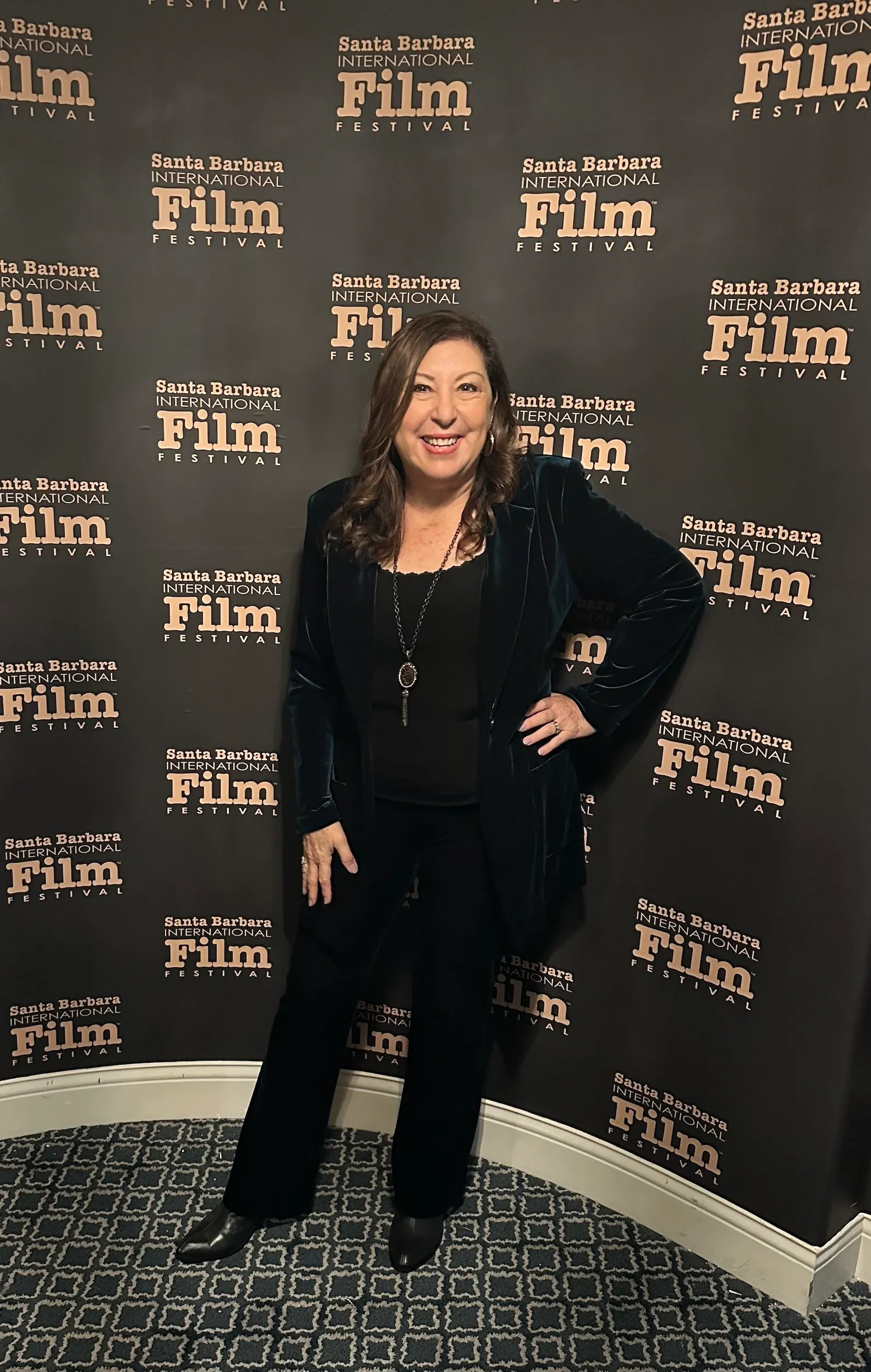
Santa Barbara International
Film Festival’s Secret Sauce
Programming Director Claudia Puig
Takes Us Behind the Scenes of the
Film Festival’s Program Puzzle
by Josef Woodard | February 8, 2024
Read the rest of our SBIFF 2024 cover story here.
Santa Barbara International Film Festival’s roster of glitzy tributes to actors — however artistically merited — can be considered as high-style window dressing, a Hollywood-linked lure for more general audiences. But beneath that starry surface lies the deep and vast foundation of the festival, a truly international film programming schedule that draws more serious cinephiles into theaters for 10 days.
Since 2022, the critical position of programming director has been impressively undertaken by an authority with the most widely known reputation of any program director in SBIFF’s history, Claudia Puig. A longtime film critic for U.S.A. Today and a former Los Angeles Times writer among other film-related connections, Puig enters her third year on the 805 job by unveiling a suitably diverse — and intentionally inclusive — tapestry of films. These films fly in from around the world (sometimes with international filmmakers also flying in for Q&As), and the overall list taps into an array of audience demographics.
The dense 2024 schedule designed by Puig and her team boasts hundreds of feature and short films, of which 45 are world premieres and 77 are U.S. premieres. On the eve of the launch of the 39th festival, I connected with Puig to get a sense of her story and mission now well in motion.
This is your third year as SBIFF’s programming director. How would you say the job and the vision you have for it have evolved over your time so far?
I think I’ve learned a good deal more about our audience and what films they particularly like over the past three years, as has our entire programming team. Speaking to audience members and also seeing what has won the Audience Award has helped me hone a clearer vision for the festival program.
My goal has been to program the most comprehensive and diverse slate I can, with films that are compelling, moving, and entertaining across a wide spectrum of genres. So, that vision remains intact and, if anything, has intensified. We are committed to showing an ever-widening breadth of films from all over the world, telling stories from as many countries and perspectives as we can in our narrative slate, and covering a broad swath of intriguing and relevant subjects in our documentary films. There are specific areas that our programming team makes a concerted search to cover, like films about the ocean and water sports, as well as the environment, given Santa Barbara’s unique and beautiful coastal location.
I feel very strongly that we need to be as inclusive as possible when it comes to filmmaking voices. We need parity of genders, and I’m especially proud that this year we are at 50 percent male and female filmmakers. We are determined to spotlight underrepresented voices and stories. I would say my vision for the festival has grown more intentional, and more focused with every year.

Did you come with particular ideas or ideals in mind, perhaps colored by your experience as a veteran festival-goer and observer?
I have been fortunate to have attended many film festivals around the world, and, even luckier, to have served on a host of film festival juries — from Ashland to Zurich. I have developed an internal barometer for what constitutes a successful film festival, and it mostly has to do with breadth and quality of films and the enthusiastic participation of filmmakers.
My fervent belief is that festivals hinge on the attendance and involvement of filmmakers. Post-screening Q&As and opportunities for the audience to interact with the people who made the films they’ve enjoyed is what sets a film festival apart from just an afternoon or evening at the local multiplex. We want to make sure that the audience has the opportunity to enter into a conversation not only with a fellow audience member, but with the filmmaker about their art.
My goal has been to encourage as many filmmakers to attend, interact, and engage with the audience. That’s an experience that cannot be replicated in any other way. Of course, you want films to run smoothly and on time, with no technical glitches, etc., but the beauty of a film festival is meeting filmmakers and cast members — whether following a screening or on the streets of Santa Barbara.
Also, festivals provide the opportunity to strike up friendships or have serendipitous meetings with others who enjoyed the same movies. Some of my favorite festival experiences have been a chance conversation with a stranger after a screening that moved us both, or meeting the filmmaker and telling them how much I loved their film. The latter is something unique to a film festival. There’s something really special about sitting in a theater and knowing you’re surrounded by people who share your passion for cinematic artistry. And then when you cap it off hearing filmmakers discuss their vision for the movie, it’s a fascinating and rewarding overall experience.
I’m also a big believer in gathering filmmakers together for panels, like our daily free 11 a.m. seminars. I love watching directors, writers, producers, editors, or actors meet each other and share stories, sometimes offering guidance when someone has a challenge or problem, other times commiserating about hurdles, and, most of all, celebrating each other’s work. It’s a joy to be able to facilitate that connection between cinematic artists.
So I guess I would say my ideal film festival is one in which there’s a lot of interpersonal communication — between the audience members, between filmgoers and filmmakers, and between the filmmakers themselves. Festivals are not about sitting and watching passively; they are events made for connection and engagement.

In terms of the nuts and bolts of programming SBIFF, roughly how many films do you and your team consider, how long does the process take, and what does the program assembly process look like?
Ah, the nuts and bolts! We spend about six months in that aspect of things — five of those watching, assessing, and selecting films. The number of submissions we receive varies yearly, from about 3,500 to 5,000 films submitted to the festival through a submission portal, plus a few hundred more that are sent to us from distributors. They will all be watched. We have several dozen additional screeners, in addition to our four-person programming team. We all watch films and rate them.
I watch about five films a day. We rate everything on a 1-5 scale that roughly categorizes to an A-F grade. The ones we consider worthy we rate 4 and 5 — which are like Bs and As. We will spend many hours in our bi-weekly programming meetings discussing the merits of each film. Our quartet of staff programmers [Puig, Natalie Gee, Ernie Quiroz, and Stewart Short] is usually pretty much in sync on what films rise to the top and what we should program, which is interesting since we range in age from twenties to sixties and come from a variety of different backgrounds. But we all share a love of movies.
Every once in a while, someone will like a film and another person will be less impressed, but in three years we’ve yet to encounter a situation where one person loves a film and another one hates it. Usually our discussions are more nuanced and detailed and focus on how the audience will react to a given film, how it fits into the overall slate, or our individual positives and negatives on filmmaking aspects, such as plot, acting, direction, writing, editing, cinematography, sound/music etc.

We start watching movies in mid-August, then we all attend the Toronto International Film Festival in early September, and from there we reach out to the films we’ve seen and liked at the festival and also to others submitted to us. We watch what filmmakers have submitted directly to FilmFreeway — the film submission portal/platform that nearly all festivals around the world use. That’s where the 3,500 to 5,000 yearly submissions come from. Then we get another few hundred films from companies that produce and distribute films that may have shown in festivals in other countries.
We are constantly in correspondence with filmmakers and production companies asking about films. It’s our mission to program primarily world and U.S. premieres, and this year we had over 70 percent that fit that bill. One of my favorite parts of the job is when you see a film you love and can contact the filmmaker and tell them how much you enjoyed their film and we lock it in as a SBIFF premiere. The filmmakers are usually thrilled, and we’re so happy about seeing a great movie. It’s such a happy moment all around.
In terms of the program assembly process, as we watch and decide on movies, we are ever mindful of genres of films that we want to include, as well as gender parity among filmmakers and even storylines and ensuring that BIPOC and LGBTQ+ filmmakers and stories are represented as well as other underrepresented voices, like the disability community, etc.
We get a lot of films submitted to us from Europe, and fewer from Africa, for instance. So we will do our own research to track down the best films from, for instance, African or Asian countries, to make sure we have global representation. We are constantly reading about and monitoring the film festivals that take place around the world and what films did well at those and were well-reviewed, etc. We follow the trade publications to see what films are in the works that might be ready in time for our festival in February.
It’s a time-consuming job, but a really great one. We watch movies for a living! There are small issues to be worked out as we assemble the films — in two of my three years on the job, we have encountered two good films with the same title, which can present confusion in our program guide, or sometimes two documentaries on the same subject.
We have all manner of discussions in programming and sometimes with other departments. We think of sponsorship possibilities, keeping regular contact with the development department. We work with the education folks and bring on interns to help us prepare for the festival. We reach out to potential jurors for the competition aspect of the festival. Those are among the issues that we discuss internally at our meetings. The programming team lives, breathes, and eats films, so we’re often communicating late into the nights or on weekends, especially in the last couple months before the festival. Thank goodness for texting.
“One of my favorite parts of the job is when you see a film you love and can contact the filmmaker and tell them how much you enjoyed their film and we lock it in as a SBIFF premiere.”
You have done an admirable job in broadening the scope of the festival’s programming and having a more inclusive overview, in terms of global representation, films by women, and seeking out new voices. Can you talk about your goals in that regard?
I feel very strongly that the scope of a good film festival should be as broad as possible and as representative and inclusive as possible. Who wants to watch movies that all come from one perspective, or just reflect the ideas and thoughts and emotions of one kind of person? I watch movies to learn about other people, other worlds, to learn and to reinforce our common humanity.
I often quote Roger Ebert’s line about films being “empathy machines,” but it is my staunch belief that the more we are exposed to a wide variety of human experiences and varied cultures and ways of approaching life, the more compassionate, understanding, knowledgeable, open-hearted, and kind we humans will be. It’s really that simple. Perhaps the most beautiful aspect of a film festival is how it exposes all of us to a plethora of experiences, lifestyles, artistry, and a vast array of thinking.
Like reading, watching movies can make us grow and be better people. If I can contribute to that betterment in even the tiniest way, I feel like it’s deeply worthwhile.

How does your vast experience as a film critic influence or interact with that of a film programmer?
As a film critic, I have always considered my purpose is to highlight the good films that people should see and steer them away from wasting their time on the lesser ones. Everyone has limited time or money. Why waste either on an experience that isn’t worth it? A film festival gathers up and puts that spotlight on the worthiest films.
My favorite aspect of being a film critic has always been to be a film champion. I loved to encourage people to see something I think they will like and value, but which they may not have heard of or been inclined to see. I think most of us critics have a kind of missionary zeal — we love to spread our enthusiasm about the best films and to encourage people to see them. One of my favorite things is when people come back to me and tell me they’ve seen a film that I recommended and they loved it. It’s that zeal and passion that drives me as a film programmer.
Both reviewing and programming are essentially curating, so the two positions dovetail and complement the other. I’m certainly not the first film critic to make the transition to festival programming, and I know I won’t be the last. It’s a natural kind of segue or evolution for critics. It feels like a seamless progression. And the focus as a festival programmer is even more on the positive when you get to program a festival of 200 films which you really like and encourage others to enjoy them too.
I do not miss writing bad reviews.
SBIFF has long kept this careful balance of Hollywood/awards season tributes and panels and a strong and dense “international” component, along with other sidebars of the film medium. That could be considered the real heart of the festival; do you see that as an identifying character of this particular festival?
SBIFF’s mission is to engage, enrich, and inspire people through film. That is the beating heart of the festival. I think the international/global component is a very essential part of the festival, which is why we pride ourselves on the range of countries our films hail from.
This year, we have films from 48 countries — and not just the usual suspects like France and Italy. We have films this year from places like Burkina Faso (Sira), Bulgaria (Blaga’s Lessons), Central African Republic (Eat Bitter), Estonia (Estonia), Iceland (Solitude), Iran (Cold Sigh), Ireland (That They May Face the Rising Sun), Mongolia (City of Wind), New Zealand (Joika), Nigeria (Madu), Tibet (Snow Leopard), Ukraine (Photophobia), as well as many other countries in Europe, South America, Asia, and also, of course, Canada and Mexico.
We are fully an international festival, and SBIFF welcomes filmmakers and film lovers from all around the globe to experience these terrific films. It’s a pleasure to introduce this marvelous array of films to eager and responsive audiences and to perhaps inspire future filmmakers. Last year, for instance, we had a film called The Prank that starred the incomparable Rita Moreno on our slate. The writer/director Maureen Bharoocha told audiences in the Q&A that she used to attend SBIFF as a little girl and the festival inspired her to pursue a career in filmmaking.
Real-life stories like that are priceless. I guess the ultimate goal would be to have one of those filmmakers who attended SBIFF in their youth be on the receiving end of one of our major awards season tributes.




You must be logged in to post a comment.